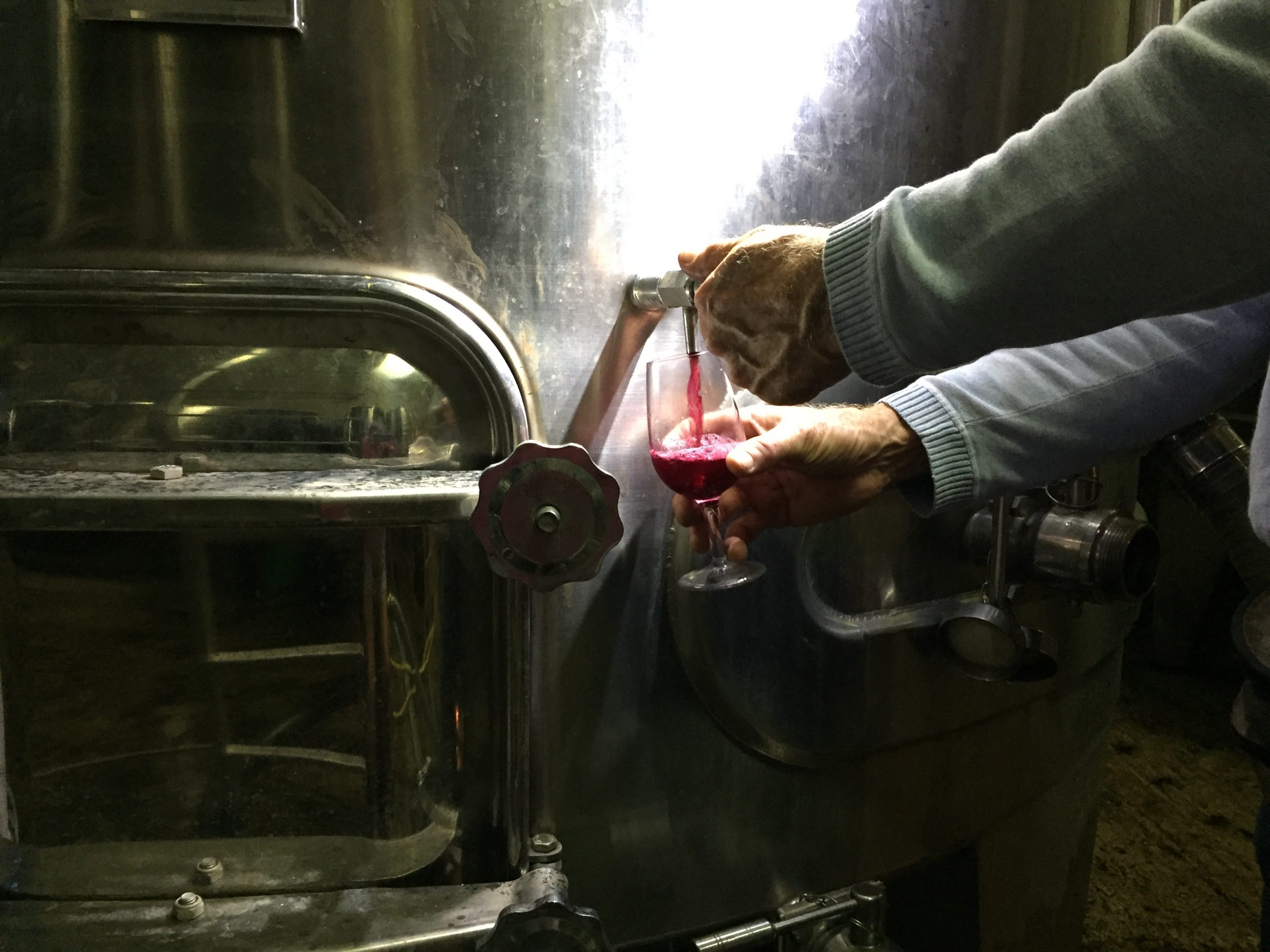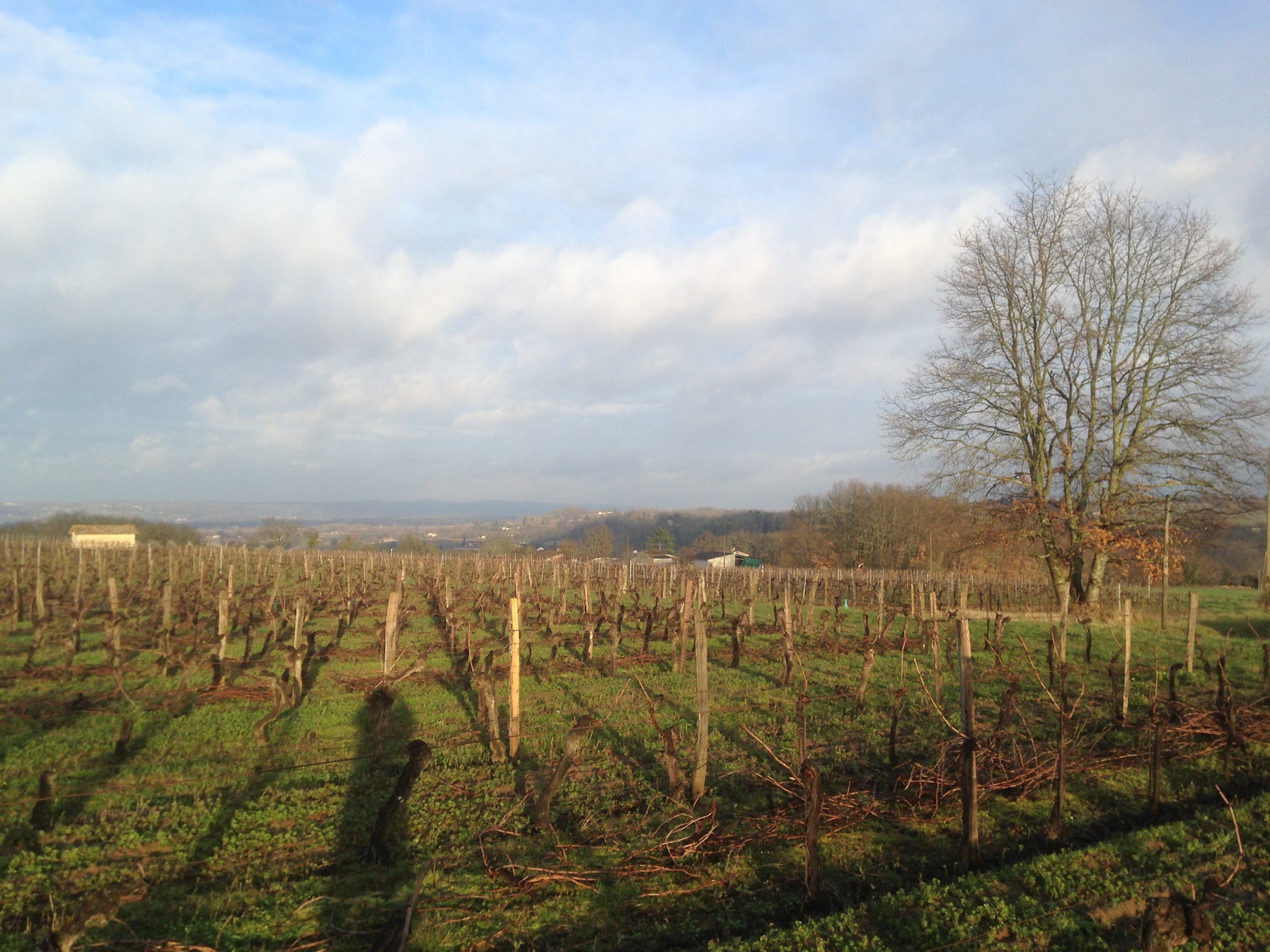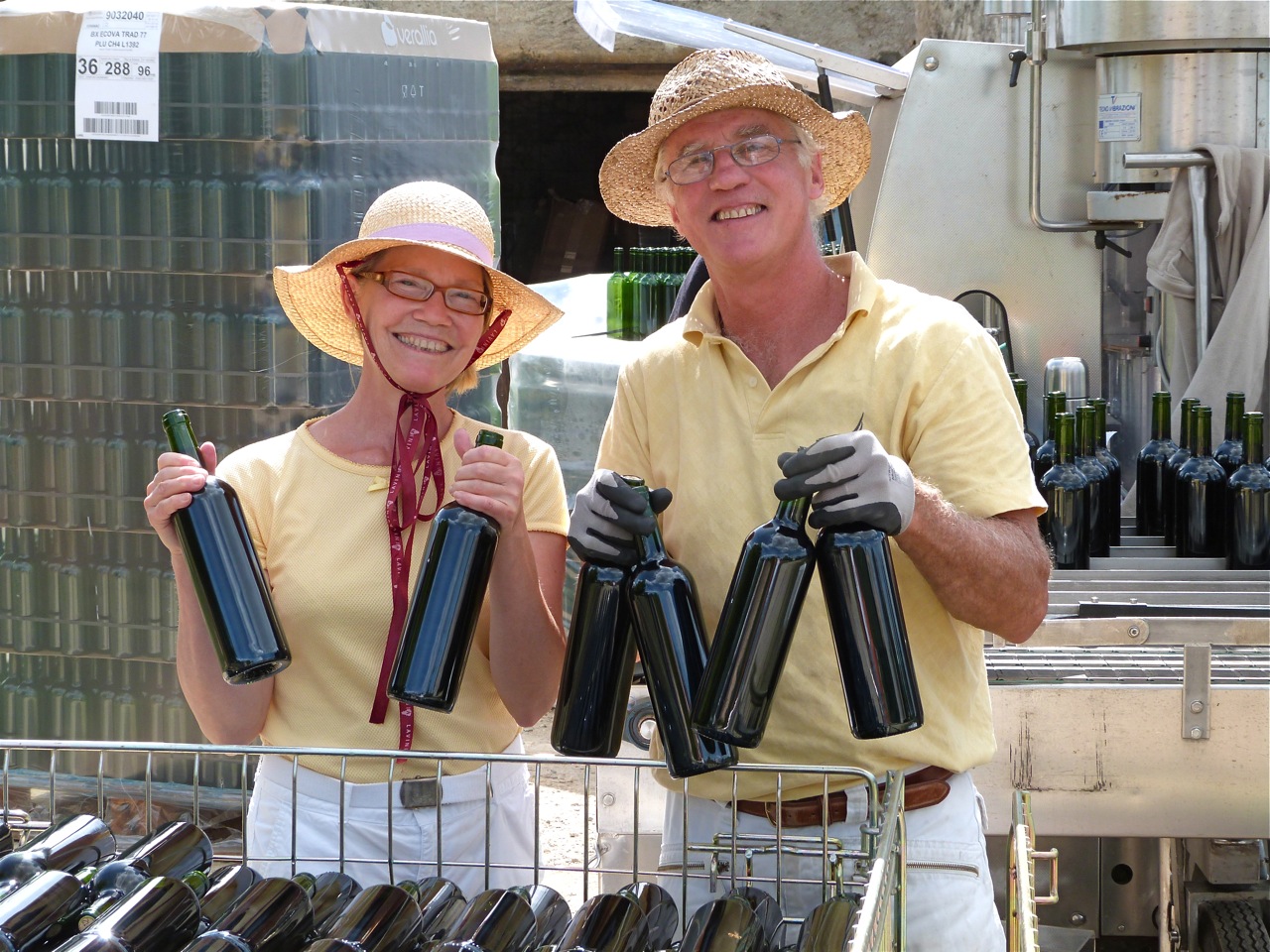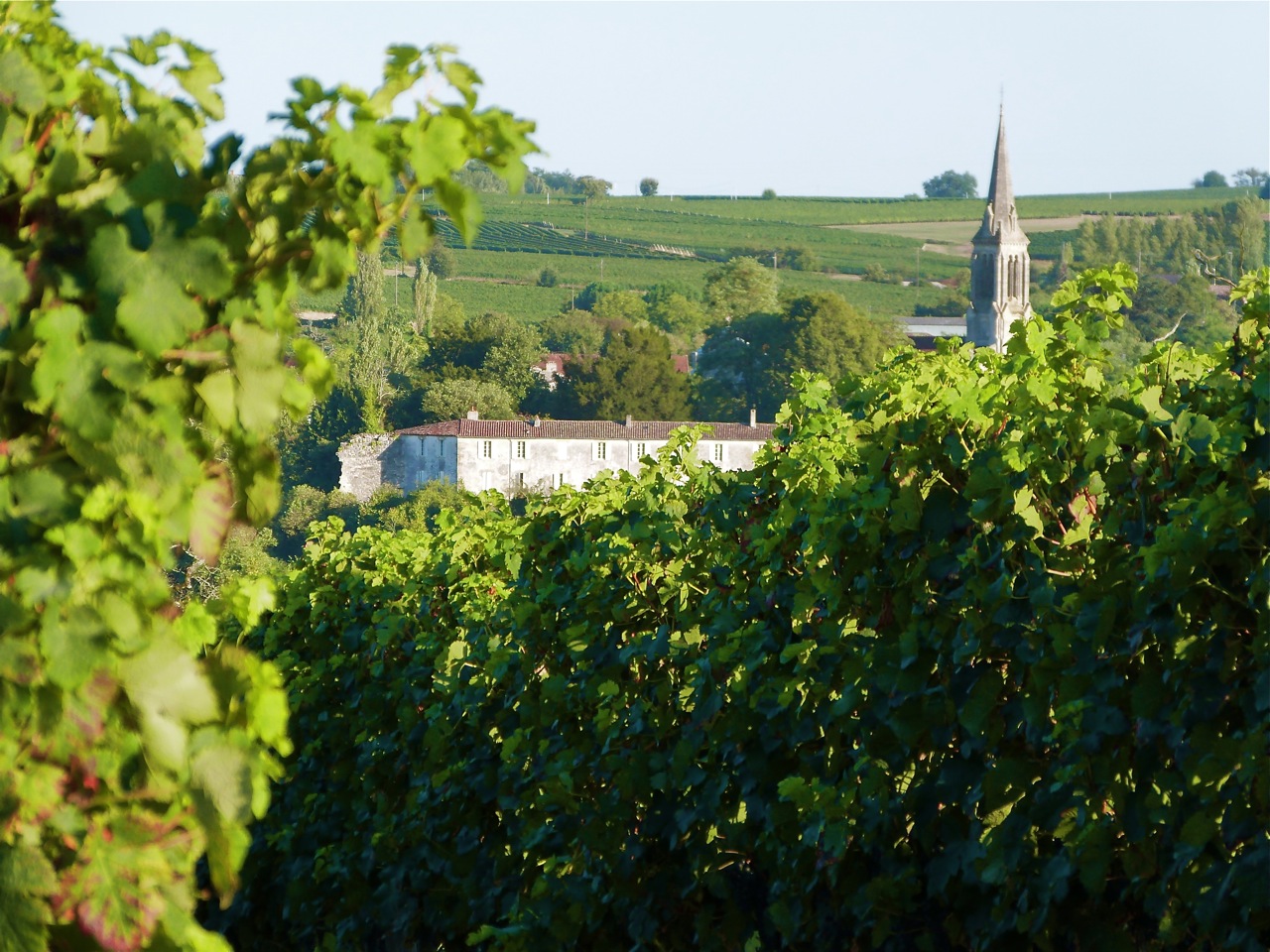 6 months ago it was a stroll through the vineyard munching on grapes after a hot bike ride through the hills. 3 months ago we were in the rows checking sugar levels with a spectometre, biting the grapes carefully to explore the pink pulp. 11 weeks ago was harvest, juice so sweet it hurt our teeth.
6 months ago it was a stroll through the vineyard munching on grapes after a hot bike ride through the hills. 3 months ago we were in the rows checking sugar levels with a spectometre, biting the grapes carefully to explore the pink pulp. 11 weeks ago was harvest, juice so sweet it hurt our teeth.
Talk about learning curves. A custom wine tasting crash course  not offered on the night class circuit – daily dipping into infant wine, childhood wine, adolescent wine… You taste each day but she’s a girl in motion who fools you at every turn.
not offered on the night class circuit – daily dipping into infant wine, childhood wine, adolescent wine… You taste each day but she’s a girl in motion who fools you at every turn.
Big wardrobe, never the same dress two days in a row.
48 hours after harvest: I walk into the chai with lacey harvest pink in mind. But the oenologue is already there, holding up a glass of something dark RED; a toddler already. We move outside for inspection in daylight and neutral air. Color: thick purple, a little cloudy. The oenologue swirls and we follow suit; it doesn’t seem an affectation here near the horse field and doesn’t matter if I spill it, which I do. The swirling helps release quantifiable characteristics of the aroma, she says, then her nose goes deep into the glass. The first criteria is “le nez” so she breathes deeply and then gets a faraway look as if scanning her olfactory files for an aroma connection. Then we raise glasses to taste. I hesitate, afraid it will be weird, but – such change in just 2 days; alive in my mouth, mini bubbles! Still sweet, but now deeper. I imitate the oenologue swishing dramatically and am relieved that most of all it tastes like effervescent fruit! She is quite approving of the fruit-ness, and I blurt, well of course it tastes like fruit, what else would it taste like?
Well. A wine-in-process can taste like many not-fruit-like things – mushrooms, rot, tar… so we smile at the wonder and luck of sweet, fermenting fruit juice that tastes like fruit, and then move on to the tricky job of getting it out of our mouths. She spits, quite gracefully. We spit, less gracefully. Apparently the experts really do pay attention to spitting etiquette but for now it’s just a quick trajectory on to the grass where the cows don’t seem to notice. After the spitting she stares at the juice in her glass as if it were a petri dish specimen. “Good fruit, but a shame you didn’t wait a few more days to harvest. 90% of the Bordeaux this year are too wet.” My knees buckle. Maybe I go white, because she seems to take pity and adds – “but today you begin the remontages. Maybe you’ll have the vintner’s luck. We shall see.”
And thus begins our bumpy baptism into the mercurial world of gestating wine.
5 days after harvest: Color: dark crushed raspberries with a dash of cream like a deeper version of my favorite frozen yogurt in NYC. Nose down in the glass I remember the advice: Try to identify each sensation as it occurs. Concentrate, because your first reaction is the one to trust. Smell: it was emanating powerfully on day 3, now it’s softer, less jagged. Still something green about it. Taste: tiny bubbles, then complex fruit flavors blending; tutti frutti; round, not sharp. Not acid. The yeast has calmed down. Texture: full, a little rough, rather deep. We spit and take a moment to assimilate. Then another sip and we allow ourselves to swallow so we can feel the juice in our throats. Pleasant surprise, no bite! A little kick, some astringency. After taste: penetrating, lingering, something vaguely woody. Sweet for sure, but doesn’t come at you “direct”; sweet that’s mixed and enrobed in something darker, like a prayer for burnt caramel.
6 days: I’m at the lab with a sample, the oneologue looks tired. Not surprising since the place is buzzing like a police station (zaniest time of year for wine folk). When the cork practically flies out of my bottle she reminds me I’ve brought her a bomb; with all this CO2 I must notch the cork so the gas can escape… Then down to tasting. I’m beginning to recognize her routine. Pour, examine, swirl, examine, sniff, reflect, taste, swish, reflect, spit, reflect, come back to earth, compute, select descriptors… “Pas mal. He’s been working the maceration. Definitely tasting the fruit. The farmers with several tanks can’t put in this much time. Pas mal du tout.”
10 days: The first fermentation is officially over so all the sugar has been transformed into alcohol. The bubbles are diminishing and so is the vague taste of yeast.
1 month: Changed again. Fuller, rounder, more complex. And yet there’s clearly something missing. We struggle for words, we come up with – “vault of a church.” What’s missing is how wine should rise and fill the palette at the top of your mouth.
5 weeks: Back at the lab to see if the malolactic fermentation has started yet; impatient because we’ve heard it makes the wine more supple, less “green apple.” The oenologue smiles, “bien aromatique” but still dry on the gums and sides of the mouth – the sign that – no, the “malo” has not yet started.
5 ½ weeks: Color: more intense. Taste: different again, more dimensions, growing complexity; now it seems to fill up your whole mouth and linger. We assume the “malo” has just started. But it still doesn’t taste like wine, there’s another thing missing. It occurs to me this missing something has to do with pleasure, a mystery element that makes your mouth – happy?
6 weeks: Color: still more intense, a darker ruby. Smell: deeper, fuller. Then a little bell tings in my nose. Yes, I detect another note, something new. Taste: Something new, indeed! I sense that our “something missing” is emerging, the “pleasure element” is coming on stage. It’s like a buttery whisper sliding around your mouth, and when you breathe back afterwards you get a second wafting of this vague buttery nutty fat something. Next, “blackberries.” Dark flavor, like forest fruit is dark. We are definitely out in some dense, boar-populated brambles.
The farmer walks in at this moment with his buddy the head of the hunt club, a man sporting rifle fatigues, a handlebar mustache and manners so formal I feel like Audrey Hepburn at the “My Fair Lady” ball. We pour them a glass. They go through the ritual as if they were born sniffing and swirling. Then approving nods all around for the great color and big taste of fruit and for once I understand the code. The farmer says he’s watched us lavish such affection on this juice we’ll have a precocious first child, but how will we keep up with this next year? Then, true to form he warns us about the risk of heavy tannins and oxidation and sneaky mushrooms invading when it’s too late to save the batch. That’s our farmer!
6 ½ weeks: Greedy for more of the pleasure principle, glass in hand, taste buds primed… hey! Who messed with our wine?! The oenologue tells us this subtle bitterness indicates the “malo” is in process. But how does she know before the lab results? Because it tastes “déstructuré.” Destructured is not yummy, but she assures us this is normal – “sometimes things have to come apart in order to find a new, more harmonious molecular arrangement.” Why am I suddenly thinking of my old therapist in New York?
7 ½ weeks: Lab report: “Malo” finished. This signals the moment we can officially call the juice “wine” whether the taste is noble or not. Also means we start getting the girl ready for her long winter’s rest, a job that takes most of the day and involves scrubbing with a toothbrush. Reward? Up to Carbonneau for a delightful, intimate dinner. When I ask Wilfrid for a glass of red, we cross his courtyard to pour a pitcher of their 2010. Really. A big tank with a spigot running cab/merlot in the back yard, what’s a home without it? Tasting his delicious one year old we pray our first born will be half as fine. And he bears good news – after the next lab test, we can start drinking our wine! It is now a “vin nouveau.”
8 ½ weeks: Oenologue’s Official Comments: Here it is, our first official report card from the Chamber of Agriculture: “nez boisé, fruité, assez complexe, structure correcte, du volume, long en bouche, boisé qui se fond.” John says this is more gratifying than the “A” he got in first grade for his bird sculpture. We both smile, and I must admit, sigh with huge relief.
8 ½ weeks: Our First Official Wine Tasting
It’s possible that most anyone can speak knowledgably about a finished wine drunk at maturity. But not very many people can taste a wine-in-process and know what it will become. So we decide to get Wilfrid and another vintner friend together to taste the gestating wines just after the “malo” while we’re all in the vin nouveau stage. After this common point our treatment paths will diverge. When the oenlogue gets wind of our plan, we’re thrilled she decides to joins us.
Our friend N. is the Maitre de Chai for a gorgeous hilltop chateau with fortifications dating from the middle ages. His chai still houses vats from the 1920’s, embellished with art nouveau style friezes of grapes on the vine, and his storage room breaks your heart with art-pretty oak barrels, burnished golden and red terra cotta floors, dramatic back lighting and stained glass windows decorated with coats of arms. He ushers us into the tasting room, practically a movie set from the Lindbergh days – wood, leather, trophy cases… all very back-room-deals ambiance. He’s set scores of glasses among our sample bottles on the tasting table and in the center a very large, ornate, intimidating, silver crachoir.
Our oenologue is everyone’s advisor, she knows all the wines by heart, the formal procedure begins. Rosés first, then the whites, reds last. She pours and we examine the color in our glasses as she presents each wine, offering technical info, but also some background about its terrain or history. We taste quietly, reflect, spit… and as the commentaries roll out I want to hug everyone for their diplomatic ways. The wine maker is the first to bring up the faults of their wine, the others murmur into their glasses, then ease into frankness, and every candid statement is couched in tones of appreciation and encouragement. (We learn later that such collegial respect is not always the case.) The oenologue gives a wrap up appraisal for each.
We don’t know why, but she pours our wine last. I wonder if she wanted to save us the embarrassment of hearing criticism followed by obvious praise for our more experienced vintner friends. Glasses raised she proclaims: “Et voila, le vin le plus chouchouté en Gironde.” (Chouchouter is what you do when you “pamper a child with tenderness.” Soft blankets, lullabies, hugs, rocking chairs – the kitchen sink, quoi.) Everyone laughs, but we all know she’s hit it on the nose. So they taste ours as we had tasted theirs and the insights, feedback and advice are excellent. We had expected to be humbled, we had hoped to learn something, and in the end, our girl stood up just fine. The extra hands-on attention and plain hard work have made the difference.
And yet, we know that nothing can replace the fact that our grapes come from a privileged plateau. If you don’t have good land, good plants, good caretaking, good weather, good work and good luck – all the engineering in the world won’t make you a truly good wine. It really is all about the fruit.




